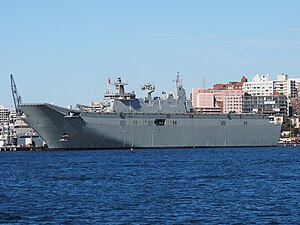Canberra-class landing helicopter dock

Canberra at Fleet Base East, June 2015
|
|
| Class overview | |
|---|---|
| Builders: | Navantia, Ferrol, Spain and BAE Systems Australia, Victoria |
| Operators: |
|
| Preceded by: | HMAS Tobruk, Kanimbla class |
| Built: | 2009–2015 |
| In commission: | 2014–present |
| Planned: | 2 |
| Completed: | 2 |
| Active: | 2 |
| General characteristics | |
| Type: | Landing Helicopter Dock |
| Displacement: | 27,500 tonnes (30,300 short tons; 27,100 long tons) at full load |
| Length: | 230.82 m (757.3 ft) |
| Beam: | 32.0 m (105.0 ft) |
| Draft: | 7.08 m (23.2 ft) |
| Propulsion: |
|
| Speed: |
|
| Range: | 9,000 nautical miles (17,000 km; 10,000 mi) at 15 knots (28 km/h; 17 mph) |
| Boats & landing craft carried: |
4 × LLC |
| Capacity: |
|
| Troops: |
|
| Complement: | 358 personnel; 293 RAN, 62 Australian Army, 3 RAAF |
| Sensors and processing systems: |
|
| Electronic warfare & decoys: |
|
| Armament: |
|
| Aircraft carried: |
|
| Aviation facilities: | Flight deck with 13 degree ski-jump, 6 in-line deck landing spots |
The Canberra class is a ship class of two Landing Helicopter Dock (LHD) ships built for the Royal Australian Navy (RAN). Planning to upgrade the navy's amphibious fleet began in 2000, based on Australian experiences leading the International Force for East Timor peacekeeping operation. With a new climate for growing Australian Navy spending, a desire existed for forward defense capability for landing and supporting troops on Asian territory, that had never existed in Australian history, even with the old Majestic-class light fleet carriers, HMAS Melbourne and HMAS Sydney in the 1970s. In 2004, French company Direction des Constructions Navales (DCN) and Spanish company Navantia were invited to tender proposals, with DCN offering the Mistral-class amphibious assault ship and Navantia proposing the "Buque de Proyección Estratégica" design (later commissioned as Juan Carlos I). The Spanish design was selected in 2007, with Navantia responsible for construction of the ships from the keel to the flight deck, and BAE Systems Australia handling the fabrication of the superstructure and fitting out.
Construction of the first ship, HMAS Canberra, commenced in late 2008, with the hull launched in early 2011, and sea trials in early 2014. Canberra was commissioned in November 2014. Work on the second vessel, HMAS Adelaide, started in early 2010. Adelaide was commissioned in December 2015. They are the largest vessels ever operated by the RAN, with a displacement of 27,500 tonnes (27,100 long tons; 30,300 short tons).
...
Wikipedia
